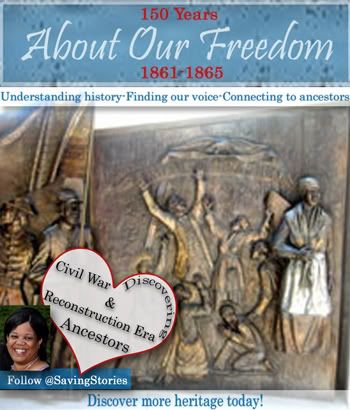We expect a great many new researchers will be trying to identify more about Civil War ancestors with this February's theme being "African American's and the Civil War" for Black History Month. We hope to be a great support to those who are starting out fresh. The blog posts on this site are being entered so that if you start with the first post, you will be able to make better sense of this process.
This journey can be quite exciting, and very easy to get off track. I have started anew many times in my research, and I am happy to do so again on your behalf this time. Those of you who have mastered the basics, just stay tuned. We are heading toward sharing resources and ideas for identifying ancestors who lived during the Civil War and Reconstruction Eras.
After you have filled out a pedigree chart, you may look at the empty spaces where names should be and feel overwhelmed by it all. Don't be.
Also, some advise to pick an ancestor that you want to learn more about the most. I suggest you focus on the first person on one of your ancestors that is missing information like birth or death dates and places. You will discover that as you locate records to fill in those details, you will find links to the missing folks the previous generation. So, start with yourself and work out from there.
Documenting the death would be the most logical place to begin researching your ancestor. Be sure you have relied on original documents. There are primary and secondary documents. Primary documentation originated at the time of the event. A birth certificate is a primary document. The birth information on a death certificate is secondary documentation.
Primary documentation is more reliable than secondary, but sometimes secondary is all we have. One of the most popular resources used for documenting recent deaths would be the Social Security Death Index.
Let's search for my grandfather, Emory W. Vance, who died in Ohio:
I entered basic information, his first and last name, and the state. It is best not to put too much information in at first. This way you are certain of bringing up the record if it is there.
Search results:
Here is the information gleaned from the SSDI:
This journey can be quite exciting, and very easy to get off track. I have started anew many times in my research, and I am happy to do so again on your behalf this time. Those of you who have mastered the basics, just stay tuned. We are heading toward sharing resources and ideas for identifying ancestors who lived during the Civil War and Reconstruction Eras.
After you have filled out a pedigree chart, you may look at the empty spaces where names should be and feel overwhelmed by it all. Don't be.
Also, some advise to pick an ancestor that you want to learn more about the most. I suggest you focus on the first person on one of your ancestors that is missing information like birth or death dates and places. You will discover that as you locate records to fill in those details, you will find links to the missing folks the previous generation. So, start with yourself and work out from there.
Documenting the death would be the most logical place to begin researching your ancestor. Be sure you have relied on original documents. There are primary and secondary documents. Primary documentation originated at the time of the event. A birth certificate is a primary document. The birth information on a death certificate is secondary documentation.
Primary documentation is more reliable than secondary, but sometimes secondary is all we have. One of the most popular resources used for documenting recent deaths would be the Social Security Death Index.
 | ||
| Social Security Death Index at FamilySearch Internet |
I entered basic information, his first and last name, and the state. It is best not to put too much information in at first. This way you are certain of bringing up the record if it is there.
 | ||
| Search for Emory Vance from Ohio |
Search results:
 | |
| Results for search: Emory Vance of Ohio |
Here is the information gleaned from the SSDI:
 |
| Social Security Death Index for Emory Vance of Ohio. |
"This index is a master index file of deaths reported to the Social Security Administration. It has been kept since 1962, when operations were computerized. The index includes about 50 percent of deceased persons from 1962 to 1971 and about 85 percent of the deceased persons from 1972 to 2005. It also includes a few deaths from 1937 to 1961. As of 2005, the index contained 76 million death records." See FamilySearch Wiki: United States Social Security Death Index to learn more.Next time, we will cover more information that you can glean from the original Social Security application and how to access that information.














